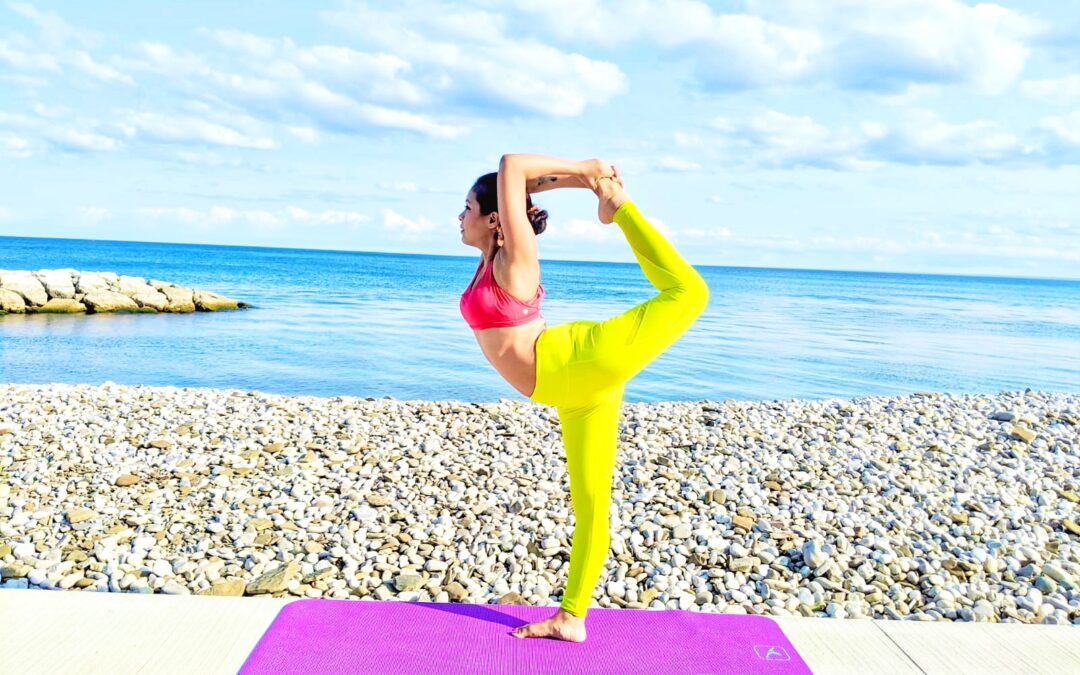Natarajasana or Lord of the Dance Pose honors Nataraja, or Lord Shiva, a Hindu deity who is believed to destroy the universe in order to recreate it. The name “Natarajasana” comes from the Sanskrit word “nata” meaning dancer and “raja” meaning, king and “asana” meaning, posture. Nataraja is one of the names given to the Hindu God Shiva’s dancing avatar. Lord Shiva is believed to do this dance to rejuvenate himself, thus restoring balance in the universe.
Lord of the Dance Pose is the cosmic dance of creation, preservation, and destruction of the universe. It is an aesthetic pose that requires immense power and balance. The pose develops grace and concentration and is also used in Bharatnatyam, an Indian classical dance form. It is a challenging standing posture that opens your back and heart. However, when you have built the strength, flexibility, and balance, you find bliss.
Meaning of Natarajasana
Natarajasana reminds us that we cannot stop the passage of time or the cycle of birth and death. However, we can find bliss amid chaos. In this pose, Lord Shiva is the metaphor for liberation from fear. By knowing and accepting the impermanence of life and the world around us, we can become fearless and feel free. Natarajasana or the Lord of the Dance Pose teaches us to overcome the fear that one feels when trying both to bend and to focus, by opening the heart or expanding the chest. The image of Lord Shiva in this pose is an embodiment of the fact that even though we are mortals, our energy never dies but only changes form.
The Lord of the Dance Pose reminds us of the circle of life, of creation and destruction, of days and nights, spring and fall. The pose teaches us to destroy what is no longer needed to make space for what we truly need. Another interpretation of the Natarajasana could be that life throws innumerable challenges at you. However, when you hold your ground and maintain your balance, you can move fearlessly through whatever you may encounter on your way.
The Mythology and Symbolism of Natarajasana
The image of Shiva dancing at the center of a wheel represents the cosmic ring of fire that symbolizes the eternal cycle of life and death. In this posture, Lord Shiva stands on one leg balancing on the demon of ignorance or avidya. The pose encourages us to rise above our ignorance, thoughts, and misunderstandings that fog our view.
Lord Shiva’s right hand is shaped in Abhaya mudra, which invokes fearlessness. On his other hand, Lord Shiva holds fire, the symbol of destruction. His third-hand holds a drum on which he beats the passage of time. In the fourth hand, he holds a conch shell that echoes the sound of Om through the universe. The foot in the air represents movement, dance, and the flow of energy. In this form of Nataraja, Shiva stabilizes himself amidst this wheel of cosmic change.
How to do Lord of the Dance Pose (Natarajasana)?
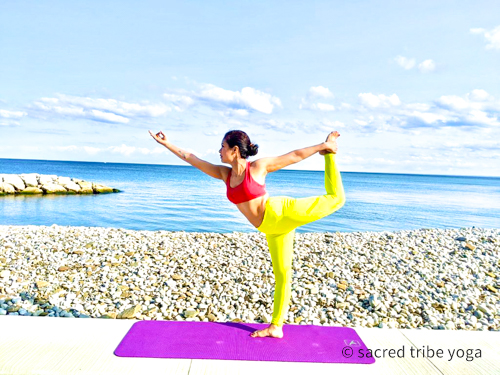
Instructions:
1. Stand on the mat with the feet together facing the front of the mat.
2. Press firmly through your feet and focus on something at your eye level.
3. Exhale and shift your weight to the right leg engaging your right thigh to make the right leg stronger. Bend your left knee and hold the outside of your left foot and bring it close to the left hip. Bring your right arm in front, stretching it out from your shoulder.
4. Now press the top of your left foot into your left hand, engaging your leg muscles, and lift the knee. As you lift the knee, keep opening your chest, and hinge at the hips.
5. Keep your left leg in line with your body and not splaying to the left side of your body. Keep your hips square. Your left leg should disappear behind you.
6. Engage the quads of the right leg and stabilize your lower core.
7. Start tilting forward, pressing your left foot into the left hand, and extending forward.
8. Extend your left thigh behind and keep lifting it as much as comfortable.
9. Hold the pose for a few seconds and then release it.
10. Repeat on the other side.
Use props
If you find it difficult to hold your foot and raise it, grab a strap. Loop it around the foot that has to be lifted and bring the strap over the shoulders in front, from the back. Pull the strap and walk your hand down the strap, keeping the elbow pointed up. Walk your hand as close as you can to your foot while maintaining your balance also. If you find yourself losing balance, you can do the pose next to a wall and put one hand on the wall for stability and balance.
Benefits
1. It is an amazing posture for people who can’t shut off their minds, as the pose requires intense focus and concentration.
2. Opens up your heart and can help you discover self-compassion and also develop empathy for others around you.
3. Spikes your metabolism and helps in weight loss.
4. Helps improve your digestion.
5. Strengthens your chest, ankles, hips, and legs.
6. Improves your balance and focus and concentration.
7. Boosts your energy levels and mitigates fatigue.
8. Stretches your shoulders, abdomen, and thighs.
9. Opens up your hip flexors also.
10. Improves confidence and promotes clarity.
Contraindications
1. Avoid the pose if you had any hip injury, pain, arthritis, or surgery.
2. Do not practice or modify the pose if you have a hamstring or groin injury.
3. All those suffering from Hernia, acute back pains, sacroiliac joint pain, shoulder pain, or injury should avoid or modify the pose.
4. If you have poor balance, try doing the pose close to a wall or use a chair for stability.
5. Do not practice the pose if you are experiencing low blood pressure.
6. Avoid stretching excessively.
Preparatory poses
- Dhanurasana
- Uttanasana
- Hanumanasana
- Ustraasana
- Ek pada rajakapotasana
Followup poses
- Uttanasana
- Garudasana
Tips/Precautions
1. If you are a beginner, you may cramp the back of your thigh. To avoid this, make sure the ankle of the lifted foot is flexed.
2. This is a deep bend so, you need to be properly warmed up.
3. Keep a slight bend in the knee of the standing leg to keep it from getting locked.
4. Keep the quads also engaged to avoid hypertension in the standing leg.
5. Drop your tailbone down and draw your abdomen up.
6. In the advanced version rotating the shoulders is a problem for some people that can be overcome by the use of a strap.
7. Keep the toes and knee of your standing leg face forward.
8. Keep your neck relaxed and not stiff.
9. Avoid any jerk, pulls, push, or attempting any forced movements.
10. Do not hold your breath. Keep breathing throughout the pose.
11. Make sure your bent knee does not splay to the side.
12. Lastly, do not be afraid to fall. Go slowly and if you fall, get back into the pose again.
Variations/Modifications
1. Standing Thigh Stretch or Quadricep Stretch
If you are a beginner, then you should start by first practicing standing thigh stretch to acquire the flexibility, strength, and balance needed to do the posture.
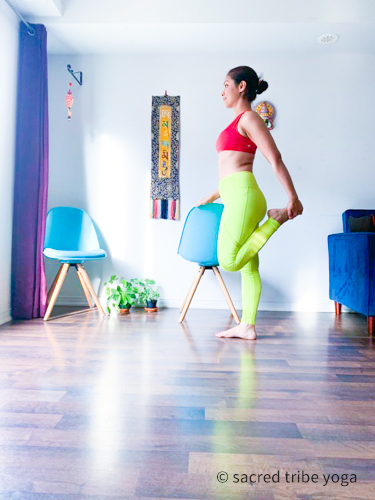
Instructions:
1. Stand with your feet close. Now grab your left foot using your left hand and pull it towards your butt. If you find it difficult to balance, then do the pose close to a wall, beside a chair, or any stable object for support.
2. Keep pushing your left foot close to your hip and feel the stretch in your quad muscles.
3. Hold the position for a few seconds and then repeat it on the other side also.
2. Mermaid Dancer Pose
This pose is a little bit challenging and needs more flexibility in the hip flexors and shoulders. So, don’t forget to do a bit of a warm-up that expands your chest and opens your shoulders.
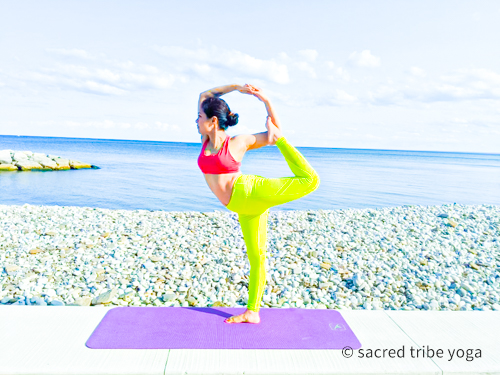
Instructions:
1. Stand on your right leg and take your left foot back. Now bring it into your left elbow using the right hand for support.
2. Inhale and start to hinge forward slightly.
3. Press your left foot down into the crease of the left elbow. Extend your right arm up toward the sky.
4. As you find your balance, take your right arm behind your head and interlock your fingers.
5. Hold the pose for a few breaths, then switch sides.
3. King Dancer Pose
This is a more advanced and deep variation, but once you enter the pose, it gets easier to keep your hips in balance.
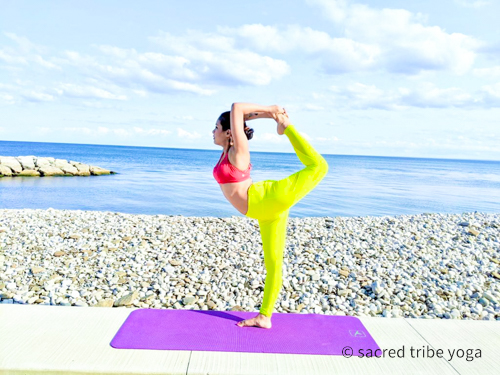
Instructions:
1. If you are comfortable doing the above-mentioned variations, hold the inside of your left foot with your left hand. Swivel your left elbow forward and then up, so that it points up towards the ceiling.
2. Bend your right elbow and reach your right hand back to hold on to the left foot. Bring your elbows in toward each other, pressing your shoulder blades down on your back.
3. Keep your pelvis square and continue lifting your chest. Press your raised foot back with both hands.
4. If using a strap around your raised foot, walk your hands slowly down the strap until you can clasp the top of your feet with both hands.
5. Hold the pose for a few breaths.
6. To release, come back to your starting position very slowly. Bring your left foot down and come back in the standing position.
7. Repeat the posture on the other side also.
The Takeaway
Lord of the Dance Pose is a deep backbend that challenges you, but once you surmount that challenge, you find inner peace, calmness, and clarity. This asana is an aesthetic combination of movement and structure. Standing firmly in the pose brings about clarity, frees you from fear of change, makes you resilient, intrepid, and sets you free. We all are also part of this rhythmic cosmic dance, and if we maintain that inner stillness like Lord Shiva, we can truly transform our lives!
Be creative and express your inspiration by coming up with your variations of the pose.

